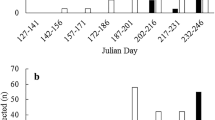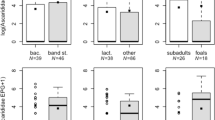Abstract
Phengaris alcon is an endangered butterfly that is subject to several conservation programs in Europe. Our study aims at evaluating how grazing pressure by domestic animals affects the maintenance of Gentiana pneumonanthe stems, larval plant host of Phengaris alcon and the survival of Phengaris alcon's eggs. We selected 304 stems of G. pneumonanthe (including 125 with P. alcon eggs) that were distributed over 4 ungrazed plots and 18 plots grazed by cattle or horses, for which we collected a grazing pressure index (Livestock Units days grazed ha−1). We monitored each stem over seven sampling sessions at 10 days intervals during the summer (from 02 July to 12 September 2018). We demonstrated that the G. pneumonanthe stems browsing probability was two times higher in the grazed plots than in the ungrazed plots. The number of eggs sharply decreased in the grazed plots, whereas it remained constant in the ungrazed plots during successive sampling sessions. Grazing, even at low intensity (10 LU days grazed ha−1), induced defoliation of G. pneumonanthe stems. The probability of the maintenance of G. pneumonanthe stems and the probability of survival of P. alcon eggs is close to zero above 20 LU days grazed ha−1. In order to protect the P. alcon population, we recommend extensive and early grazing (before mid-July) before the growth of G. pneumonanthe stems, or late grazing (after early September) avoiding the development period of G. pneumonanthe, the oviposition period and the early caterpillar development of P. alcon. Alternatively, we suggest the establishment of temporary exclosures on high densities areas of G. pneumonanthe between mid-July to early September.




Similar content being viewed by others
References
Arnyas E, Bereczi J, Toth A, Pecenye K, Varga Z (2006) Egg-laying preferences of the xerophilous ecotype of Maculinea alcon (Lepidoptera: Lycaenidae) in the Aggtelek National Park. Eur J Entomol 103(3):587–595. https://doi.org/10.14411/eje.2006.079
Bale JS, Masters GJ, Hodkinson ID (2002) Herbivory in global climate change research: direct effects of rising temperatures on insect herbivores. Glob Change Biol 8:1–16
Bates D, Maechler M, Bolker B, Wlaker S, Christensen RH, Singmann H, Dai B, Sckeipl F, Grothendieck B, Green P (2018) Package lme4. Cran.
Clarke RT, Mouquet N, Thomas JA, Hochberg ME, Elmes GW, Tesar D, Singer A, Hale J (2005) Modelling the local population dynamics of Maculinea and their spatial interactions with their larval foodplant and Myrmica ant species. Studies in the ecology & conservation of butterflies in Europe II. Pensoft Publishers, Sofia, p 115–119.
Cremene C, Gheorghe G, Loaszl R, Schileyko AA, Baur A, Erhardt A, Baur B (2005) Alterations of steppe-like grasslands in Eastern Europe: a threat to regional biodiversity hotspots. Conserv Biol 19(5):1606–1618. https://doi.org/10.1111/j.1523-1739.2005.00084.x
Czekes Z, Mark BA, Nash DR, Ferencz MA, Lazar B, Rakosy M (2013) Differences in oviposition strategies between two ecotypes of the endangered myrmecophilous butterfly Maculinea alcon Lepidoptera: Lycaenidae) under unique syntopic conditions. Insect Conserv Divers 7(2):122–131. https://doi.org/10.1111/icad.12041
Dolek M, Geyer A (2002) Conserving biodiversity on calcareous grasslands in the Franconian Jura by grazing: a comprehensive approach. Biol Conserv 104:351–360
Dupont P (2010) Plan national d’actions en faveur des Maculinea. Office pour les insectes et leur environnement—Ministère de l’Ecologie, du Développement durable, des Transports et du Logement. p 138.
Dupont P, Bachelard P (2010) Pâturage ou fauche? Le cas de la gestion conservatoire de l’Azuré des mouillères dans les zones humides. In: Lumaret JP (ed) Pastoralismes et entomofaune. Pastum hors-série, AFP, CEFE and Cardère éditeur, pp 61–73
Elmes GW, Thomas JA, Wardlaw JC (1991) Larvae of Maculinea rebeli, a large-blue butterfly, and their Myrmica host ants: wild adoption and behaviour in ant nests. J Zool 223:447–460
Elmes GW, Thomas JA, Hammarstedt O, Munguira ML, Martin J, Van Der Made JG (1994) Differences in host ants specificity between Spanish, Dutch and Swedish populations of the endangered butterfly Maculinea alcon (Denis et Schiff.) (Lepidoptera). Zoology 48:55–68
Elmes GW, Clarke RT, Thomas JA, Hochberg ME (1996) Empirical tests of specific predictions made from a spatial model of the population dynamics of Maculinea rebeli, a parasitic butterfly of red ant colonies. Actaoecologica 17:61–80
Furst MA, Nash DR (2010) Host ant independent oviposition in the parasitic butterfly Maculinea alcon. Biol Lett 6:174–176
Habel JC, Schmitt T, Hardtle W, Lukepohl M, Assman T (2007) Dynamics in a butterfly-plant-ant system: influence of habitat characteristics on turnover rates of the endangered lycaenid Maculinea alcon. Ecol Entomol 32(5):536–543. https://doi.org/10.1111/j.1365-2311.2007.00903.x
Hochberg ME, Clarke RT, Elmes GW, Thomas JA (1994) Population dynamic consequences of direct and indirect interactions involving a large blue butterfly and its plant and red ant hosts. J Anim Ecol 63:375–391. https://doi.org/10.2307/5555
Isselstein J, Jeangros B, Pavlu V (2005) Agronomic aspects of biodiversity: targeted management of temperate grasslands in Europe. Agron Res 3:139–151
Jerrentrump JS, Wragemnnig N, Roverl KU, Isselstein J (2014) Grazing intensity affects insect diversity via sward structure and heterogeneity in a long-term experiment. Ecology 51:968–977
Korösi A (2005) Habitat-use of wetland Maculinea species: a case study. In: Settele J, Kühn E, Thomas JA (ed) Studies on the ecology and conservation of butterflies in Europe, vol 2. Species ecology along a European gradient: Maculinea butterflies as a model. Pensoft, Sofia, p 132.
Krenova Z, Leps J (1996) Regeneration of a Gentiana pneumonanthe population in an oligotrophic wet meadow. J Veg Sci 7:107–112
Kruess A, Tscharntke T (2002) Grazing intensity and the diversity of grasshoppers, butterflies, and trap-nesting bees and wasps. Conserv Biol 16(6):1570–1580. https://doi.org/10.1046/j.1523-1739.2002.01334.x
Lhonore J (1998) Biologie, écologie et répartition de quatre espèces de Lépidoptères Rhopalocères protégés (Lycaenidae, Satyridae) dans l'Ouest de la France. Rapport d’études de l’OPIE, vol 2. https://www.inra.fr/opie-insectes/re-rhopa.htm. Accessed 27 september 2000
Miller GR, Geddes C, Mardon DK (1999) Response of the alpine gentian Gentiana nivalis L. to protection from grazing by sheep. Biol Conserv 87:311–318
Mouquet N, Belrose V, Thomas JA, Elmes GW, Clarke RT, Hochberg ME (2005) Conserving community modules: a case study of the endangered Lycaenid butterfly Maculinea alcon. Ecology 86(12):3160–3173. https://doi.org/10.1890/04-1664
Nowicki P, Pepkowska A, Kudlek J, Skorka P, Witek M, Settle J, Woyciechowski M (2007) From metapopulation theory to conservation recommendations: Lessons from spatial occurrence and abundance patterns of Maculinea butterflies. Biol conserv 140(1–2):119–129. https://doi.org/10.1016/j.biocon.2007.08.001
Oostermeijer JGB (1999) Population viability analysis of the rare Gentiana pneumonanthe: the importance of genetics, demography and reproductive biology. Ecology 18:313–334
Oostermeijer JGB, Van’t Veer R, Den Nijs JCM, (1994) Population structure of the rare, long-lived perennial Gentiana pneumonanthe in relation to vegetation and management in the Netherlands. J Appl Ecol 31:428–438
Parc national des Cévennes (1992) Annales du Parc national des Cévennes, tome 5
Poschlod P, WallisDeVries M (2002) The historical and socioeconomic perspective of calcareous grassland lessons from the distant and recent past. Biol conserv 104(3):361–376. https://doi.org/10.1016/S0006-3207(01)00201-4
R Core Team (2018) R: a language and environment for statistical computing. R Foundation for Statistical Computing, Vienna, Austria
Rook AJ, Dumont B, Isselstein J, Osoro K, WallisDeVries MF, Parente G, Mills J (2004) Matching type of livestock to desired biodiversity outcomes in pastures: a review. Biol Conserv 119(2):137–150. https://doi.org/10.1016/j.biocon.2003.11.010
Sckonrogge JC, Wardalw JA, Thomas GW (2000) Polymorphic growth rates in myrmecophilous insects. Biol Sci 267(1445):771–777. https://doi.org/10.1098/rspb.2000.1070
Tallowin JRB, Rook AJ, Rutter SM (2005) Impact of grazing management on biodiversity of grasslands. Anim Sci 81:193–198. https://doi.org/10.1079/ASC50780193
Thomas JA, Elmes GW (1998) Higher productivity at the cost of increased host-specificity when Maculinea butterfly larvae exploit ant colonies through trophallaxis rather than by predation. Ecol Entomol 23(4):457–464. https://doi.org/10.1046/j.1365-2311.1998.00153.x
Thomas JA, Elmes GW, Wardla JC (1993) Contest competition among Maculinea rebeli butterfly larvae in ant nests. Ecol Entomol 18:73–76
Van Dyck H, Oostermeijer JBB, Talloen W, Feenstra V, Van Der Hidde A, Wynhoff I (2000) Does the presence of ant nests matter of ovipositionto a specialized myrmecophilous Maculinea butterfly? Proc R Soc London 1466:861–866
Van Swaay C, Cuttelod A, Collins S, Maes D, López Munguira M, Šašić M, Settele J, Verovnik R, Verstrael T, Warren M, Wiemers M, Wynhof I (2010) European red list of butterfies. Publications Office of the European Union, Luxembourg
Veen P, Jefferson R, De Smidt J, Vanderstraaten J (2009) Grasslands in Europe. KNNV publishing, Netherlands, p 320
WallisDeVries MF (2004) A quantitative conservation approach for the endangered butterfly Maculinea alcon. Conserv biol 18(2):489–499. https://doi.org/10.1111/j.1523-1739.2004.00336.x
WallisDeVries MF, Raemakers I (2001) Does extensive grazing benefit butterflies in coastal dunes? Ecology 9(2):179–188. https://doi.org/10.1046/j.1526-100x.2001.009002179.x
Wettstein W, Schmid B (1999) Conservation of arthropod diversity in mountain wetlands: effect of altitude, habitat quality and habitat fragmentation on butterflies and grasshoppers. Ecology 36(3):363–373. https://doi.org/10.1046/j.1365-2664.1999.00404.x
Witek M, Sliwinska EB, Skorka P, Settele J, Woyciechowski M (2006) Polymorphic growth in larvae of Maculinea butterflies, as an example of biennialism in myrmecophilous insects. Oecologia 148:729–733
Wynhoff I, Bakker RB, Oteman B, Arnaldo PS, van Langevelde F (2015) Phengaris (Maculinea) alcon butterflies deposit their eggs on tall plants with many large buds in the vicinity of Myrmica ants. Insect Conserv Divers 8:177–188
Acknowledgements
We would like to thank all the agents of the Cevennes National Park (Sylvie Coenders, Isabelle Malafosse, Valérie Quillard, Philippe Lucas) and Françoise Plancheron (Office National des Forêts) for their contribution to the collection of data in the field. The authors would like to thank two anonymous reviewers for making valuable comments and suggestions for improving this paper.
Author information
Authors and Affiliations
Corresponding author
Ethics declarations
Conflict of interest
The authors declare they have no conflict of interest.
Additional information
Publisher's Note
Springer Nature remains neutral with regard to jurisdictional claims in published maps and institutional affiliations.
Rights and permissions
About this article
Cite this article
Moschetti, M., Besnard, A., Couturier, T. et al. Grazing intensity negatively affects the maintenance of Gentiana pneumonanthe and the survival of Phengaris alcon egg-laying. J Insect Conserv 24, 343–351 (2020). https://doi.org/10.1007/s10841-020-00220-8
Received:
Accepted:
Published:
Issue Date:
DOI: https://doi.org/10.1007/s10841-020-00220-8




